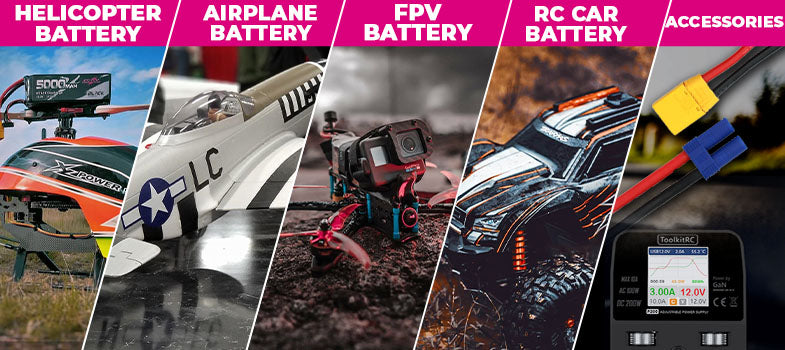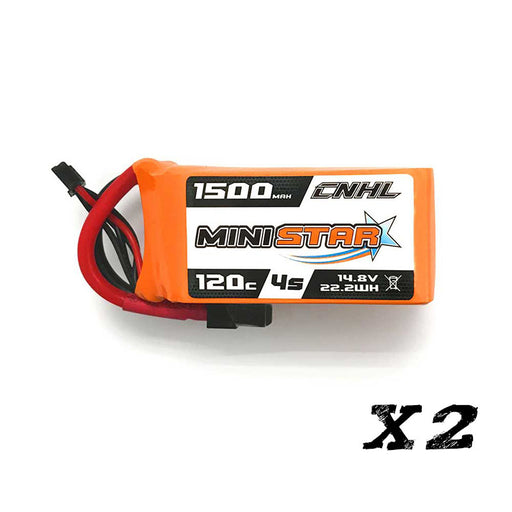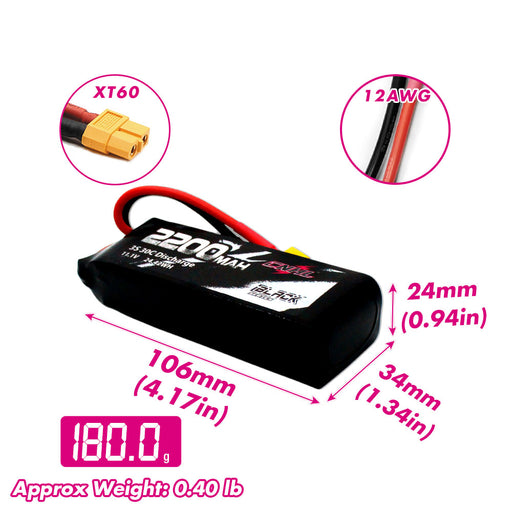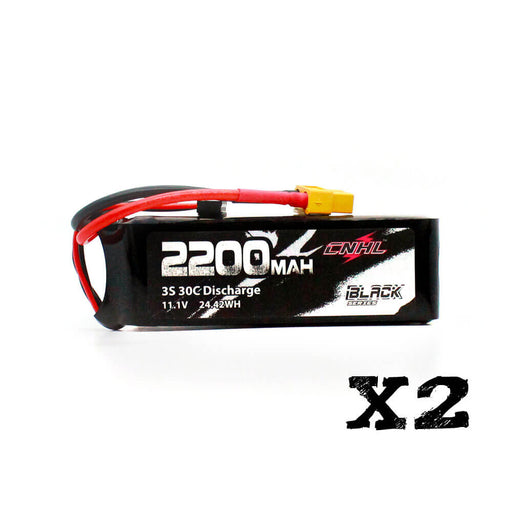
リポバッテリーの充電方法と並列充電方法
バッテリーはFPV趣味の中で最も退屈な部分ですが、残念ながら最も重要な部分の一つでもあります。特にこれから始める皆さんにとっては。
このブログでは、リポバッテリーを効率的かつ安全に充電する方法について話します。
まず、1つのバッテリーを一度に充電する方法について話しましょう。手順はとても簡単です。まず充電器を接続し、次にこのようなXT60コネクターを最初に接続します。

そしてバランスポートですが、ピンがバランスポートに正しく合っていることを確認してください。通常、ピン番号1は右側にあります。

左に移動すると、これでバッテリーと各セルの電圧を読み取ることができます。私の充電器は4sバッテリーが接続されたことを自動的に検出し、正しい電圧に設定して充電します。

充電器にこの機能があるかどうかに関わらず、常にセルあたり4.2ボルトまで充電していることを二重に確認してください。それ以上充電すると深刻な問題が発生する可能性があります。参考のためにここにチャートも含めます。

これにより、セル数に基づいてリポバッテリー全体をどこまで充電すべきかがわかります。
| 1s | 4.2v |
| 2s | 8.4v |
| 3s | 12.6v |
| 4s | 16.8v |
| 5s | 21.0v |
| 6s | 25.2v |
だから、バッテリーにどれだけ充電すればいいかは簡単にわかります。常にセルあたり4.2ボルトまで充電したいからです。しかし、どれくらいの速さで充電するかを決めることも重要です。多くの充電器はさまざまな速度でバッテリーを充電できますが、速ければ速いほど良いわけではありません。バッテリーを充電する最も安全な方法は1C、つまり容量の1倍の速度で充電することです。例えば、この1500ミリアンペア時、つまり1.5アンペア時のバッテリーを1Cで充電したい場合は、1.5アンペアで充電します。

これは850ミリアンペア時、つまり0.85アンペア時のバッテリーなので、0.8アンペアから0.9アンペアの間で充電したいです。

繰り返しますが、これはバッテリーを充電する最も安全な方法です。しかし、欠点もあります。バッテリーのサイズに関係なく、完全に空の状態から1Cレートで充電するには非常に長い時間がかかります。45分弱かかります。現在私は8つのバッテリーを持っているので、もしそれらをすべて別々に1Cで充電すると、1つあたり45分かかるので、合計で約6時間かかります。2ポートの充電器で2つのバッテリーを同時に充電できても、それでも3時間かかります。
幸いにも、充電を速める方法は2つあります。まず、電流を増やすことができ、1Cで充電する代わりに2C、つまり容量の2倍の速度で充電すれば、2倍速で充電できます。時間に本当に追われている場合は、時々3Cや4Cで充電しても大丈夫だと言う人もいますが、充電速度が速くなるほど危険性が増します。充電中に何も起こらなくても、高いCレートで充電する頻度が増えるほど、バッテリーの劣化は進みます。したがって、可能な限り1Cの速度を守ることをお勧めします。どうしても時間がない場合は2Cまで上げてもいいかもしれませんが、緊急時でない限りそれ以上は避けてください。バッテリーは可燃物から離し、リポ火災のリスクを覚悟している場合のみです。
電流を上げたくない場合のもう一つの選択肢は並列充電です。並列充電とは、下の画像のような並列充電ボードを使うことで、一度に1つの充電器で充電できるバッテリーの数を増やせることを指します。

ポートごとに1つのバッテリーを充電する代わりに、このボードを使えば最大6つまで充電できます。バッテリーを高速で充電するのと同様に、並列充電も誤って行うと少しリスクが高まる可能性があります。だからこそ、充電する前に毎回いくつかの事前手順を踏む必要があります。まず、並列充電を安全かつ確実に行うために、すべてのバッテリーが同じセル数であることを確認してください。3sのバッテリーを4sで充電したり、4sを5sで充電したりしてはいけません。4s LiPoバッテリーを充電する場合は、すべてが4sであることを確認してください。そうでないと、充電器はすべてのバッテリーに均等にアンペアを分配しようとし、小さいバッテリーが過充電されてしまい、非常に危険です。さらに安全を期すために、通常は同じブランドかつ同じモデルのバッテリーのみを並列充電します。異なるブランドのバッテリーはわずかに組成が異なる可能性があり、すべてのバッテリーが同一であることを確認するだけで、愚かなミスを避けるのが非常に簡単になります。
次に、一緒に充電しようとするすべてのバッテリーが似たような電圧であることを確認したいです。理想的には、このボードに接続するとき、これらすべてのバッテリーが
それらの電圧が正確に同じである必要があります。前述したように、充電器は4つの小さなバッテリーではなく1つの大きなバッテリーを充電していると認識し、電流を均等に分配して均等に充電しようとします。電圧に差があると、一部のバッテリーが過充電される可能性があり、これは非常に危険です。幸いなことに、多少の余裕があり、セルあたり最大0.1ボルトの差までのバッテリーは一緒に充電できます。これはセルあたりの差なので、4セルバッテリーの場合は全体で最大0.4ボルトの差まで許容されます。
ここに4セルのバッテリーが8個あり、それぞれの電圧は以下の通りです。

これらのバッテリーは並列で安全に充電できますが、これらは別のグループとして充電する必要があります。これら2つのグループ内では最大0.4ボルトの差があり、これは安全に充電できる範囲です。この最後のバッテリーは他のものと電圧が大きく異なるため、別々に充電する必要があります。もしこのバッテリーを他のものと一緒に充電すると、どれかのバッテリーが過充電されるリスクがあります。
では、実際にどうやるかをお見せします。まずはバランスボードを接続してください。

バランスボードにバッテリーを接続する際は、バランスリードの前にこのXT60コネクターを接続することをお勧めします。ただし、すでにすべてのバッテリーの電圧がほぼ同じであることを確認している場合は、どちらでも大きな問題ではありません。バランスリードを接続する際は、正しいポートに正しい方向で接続していることを確認してください。コネクターの片側には方向を示す小さなガイドがありますが、ほとんどのボードでのコツは、バッテリーの赤い線が内側に来ることが多いということです。ショートを避けるために、これらをゆっくりと差し込んでください。

また、並列充電ボードにはおそらく両側にバウンスコネクターがあり、どちらに接続してもピンの数が合っていれば問題ありません。接続した後は少しそのままにしておくことをお勧めします。もし電圧を表示できる充電器をお持ちなら、各バッテリー間の電圧がさらに調整され、以前よりも近い電圧でバランスが取れていくのがわかるでしょう。数分間落ち着いた後、充電を開始できます。並列充電の場合、1C以上の速度で充電することは決してお勧めしませんが、1つのバッテリーに対する1Cと4つのバッテリーに対する1Cは大きく異なります。
前に述べたように、この1500ミリアンペアのバッテリーの場合、1.5アンペアの電流が欲しいですが、もしこれらのバッテリーを4つ1.5アンペアで充電すると、電力は4つのバッテリーに分割され、実際にはそれぞれ0.375アンペアで充電されることになります。これはもはや1Cではなく約0.25Cで、つまり4倍のバッテリーを同時に充電する場合、充電電流も4倍にでき、充電器を6アンペアに設定してこれら4つのバッテリーを充電できます。充電器はそのアンペア数をバッテリー間で分割し、それぞれに1.5アンペアを供給します。それだけのことです。すべてのバッテリーは同時に充電され、充電が終わると充電器はバッテリー内のすべてのセルのバランスも取ります。また、もし前に明確でなかった場合のためにもう一つ付け加えたいのは、一部の充電器には2つの独立したポートまたはチャネルがあり、2つの異なる完全に独立した作業を行えることです。チャネル1に接続されたものはチャネル2には影響しません。実際、これらは1つに組み込まれた2つの別々の充電器として扱うことができるので、4セルバッテリーを他のものと一緒に充電できなかったとしても、別のチャネルに接続すればチャネル1で起こることはチャネル2に影響しません。チャネル2に3セルバッテリーを接続しても、チャネル1での4セルバッテリーの並列充電には影響しません。唯一覚えておくべきことは、両方のチャネルが電源から引き出せるアンペア数を共有することです。つまり制限があり、充電器は電源から引き出せる最大アンペア数があり、チャネル1と2での充電の合計がその数を超えることはできません。

これでこのブログは終わりです。このビデオから何か学んだと感じたら、ぜひシェアしてください。

ベストセラー
-
元の価格 $65.99元の価格 $65.99 - 元の価格 $65.99元の価格 $65.99$53.99 USD - $65.99 USD$53.99 - $65.99現在の価格 $53.99 USD
CNHL G+Plus 5000mAh 22.2V 6S リポバッテリー 70C EC5プラグ付き
在庫に10以上あります仕様: ストック番号: 500706EC5 容量: 5000mAh 電圧: 22.2V / 6セル / 6S1P 放電率: 70C 継続 / 140C バースト 充電率: 最大5C サイズ(1-5mmの誤差): 49X51X149mm(高さ*幅*長さ) おおよその重量(±5g) : 71...
詳細をすべて表示元の価格 $65.99元の価格 $65.99 - 元の価格 $65.99元の価格 $65.99$53.99 USD - $65.99 USD$53.99 - $65.99現在の価格 $53.99 USD最大18%節約 -
元の価格 $38.99元の価格 $38.99 - 元の価格 $38.99元の価格 $38.99$34.99 USD - $38.99 USD$34.99 - $38.99現在の価格 $34.99 USD
CNHL スピーディーピザシリーズ プロ 1350mAh 22.2V 6S 150C リポバッテリー XT60プラグ付き
残り10台のみ仕様: 在庫番号: 1351506PZ 容量:1350mAh 電圧:22.2V / 6セル / 6S1P 放電率:連続150C / バースト300C 充電率:最大5C サイズ(1-5mmの差異あり):38X38X78mm おおよその重量(±5g):215g 出力コネクター:XT60 バラン...
詳細をすべて表示元の価格 $38.99元の価格 $38.99 - 元の価格 $38.99元の価格 $38.99$34.99 USD - $38.99 USD$34.99 - $38.99現在の価格 $34.99 USD最大10%節約 -
元の価格 $51.98元の価格 $51.98 - 元の価格 $51.98元の価格 $51.98$46.78 USD - $51.98 USD$46.78 - $51.98現在の価格 $46.78 USD
2パック CNHL ブラックシリーズ V2.0 1300mAh 22.2V 6S 130C リポバッテリー XT60プラグ付き
在庫に10以上あります仕様 在庫番号: 1301306BK 容量: 1300mAh 電圧: 22.2V / 6セル / 6S1P 放電率: 130C 継続 / 260C バースト 充電率: 最大5C サイズ(1-5mmの差異あり): 48X33X77mm 重量(±5g): 210g 出力コネクター: XT60 バ...
詳細をすべて表示元の価格 $51.98元の価格 $51.98 - 元の価格 $51.98元の価格 $51.98$46.78 USD - $51.98 USD$46.78 - $51.98現在の価格 $46.78 USD最大10%節約 -
元の価格 $43.98元の価格 $43.98 - 元の価格 $43.98元の価格 $43.98$31.98 USD - $43.98 USD$31.98 - $43.98現在の価格 $31.98 USD
[Combo] 2パック CNHL MiniStar 1500mAh 14.8V 4S リポバッテリー 120C XT60プラグ付き
在庫に10以上あります仕様: 在庫番号:1501204 容量:1500mAh 電圧:14.8V / 4セル / 4S1P 放電率:連続120C / バースト240C 充電率:最大5C サイズ(1-5mmの差異):37X33X76mm おおよその重量(±5g):169g 出力コネクター:XT60 バランスコネクター...
詳細をすべて表示元の価格 $43.98元の価格 $43.98 - 元の価格 $43.98元の価格 $43.98$31.98 USD - $43.98 USD$31.98 - $43.98現在の価格 $31.98 USD最大27%節約 -
元の価格 $23.98 - 元の価格 $37.98元の価格 $23.98 - 元の価格 $37.98元の価格 $23.98$19.98 USD - $37.98 USD$19.98 - $37.98現在の価格 $19.98 USD
2パック CNHL ブラックシリーズ 2200mAh 3S 11.1V 30C リポバッテリー XT60プラグ付き
在庫に10以上あります仕様: 在庫番号:220303BK 容量:2200mAh 電圧:11.1V / 3セル / 3S1P 放電率:30C連続 / 60Cバースト 充電率:最大5C サイズ(1-5mmの誤差あり):24X34X106mm おおよその重量(±5g):180g 出力コネクター:XT60 バランスコネク...
詳細をすべて表示元の価格 $23.98 - 元の価格 $37.98元の価格 $23.98 - 元の価格 $37.98元の価格 $23.98$19.98 USD - $37.98 USD$19.98 - $37.98現在の価格 $19.98 USD最大17%節約
新しいアイテム
-
元の価格 $225.00 - 元の価格 $225.00元の価格 $225.00$225.00 USD$225.00 - $225.00現在の価格 $225.00 USD
CNHL Havok 1000mm 高速 4S スポーツレーサー RC 飛行機 PNP(高視認性イエロー/レッドエディション)
残り9台のみCNHL Havok 1000mm 4Sスポーツレーサープレーン – 実績ある1m Havok機体をベースに CNHL Havok 1000mm 4SスポーツレーサーRCプレーンPNPは、日常の実用性を犠牲にせずアドレナリンを求めるパイロット向けの1メートルフォームスピードプレーンです。...
詳細をすべて表示元の価格 $225.00 - 元の価格 $225.00元の価格 $225.00$225.00 USD$225.00 - $225.00現在の価格 $225.00 USD -
元の価格 $120.00 - 元の価格 $120.00元の価格 $120.00$120.00 USD$120.00 - $120.00現在の価格 $120.00 USD
MNRC MN300 RTR 1/12スケール 4WD RC ロッククローラー オフロードトラック 2速トランスミッション付き
残り9台のみMNRC MN300は1/12スケールのレディトゥラン(RTR)4WD RCロッククローラーで、軽いクローリング、トレイル走行、日常のオフロードの楽しみのために作られています。電子機器が組み込まれた状態で組み立て済みで、7.4VバッテリーとUSB充電ケーブルが箱に同梱されています。「全か無...
詳細をすべて表示元の価格 $120.00 - 元の価格 $120.00元の価格 $120.00$120.00 USD$120.00 - $120.00現在の価格 $120.00 USD -
元の価格 $119.99 - 元の価格 $119.99元の価格 $119.99$119.99 USD$119.99 - $119.99現在の価格 $119.99 USD
VOLANTEX スピットファイア RC 飛行機 4チャンネル 6軸ジャイロ安定化機能付き すぐに飛ばせる
残り9台のみ第二次世界大戦の伝説的な英国戦闘機に触発されたVOLANTEX スピットファイア RCプレーンは、クラシックな戦闘機の外観と初心者に優しい最新の飛行制御を融合しています。VOLANTEXの実績ある400mmプラットフォームを基に構築され、このすぐに飛ばせるRC飛行機はXPILOT安定化...
詳細をすべて表示元の価格 $119.99 - 元の価格 $119.99元の価格 $119.99$119.99 USD$119.99 - $119.99現在の価格 $119.99 USD -
元の価格 $122.99 - 元の価格 $122.99元の価格 $122.99$122.99 USD$122.99 - $122.99現在の価格 $122.99 USD
VOLANTEX BF109 RC 飛行機 4チャンネル RTF – ジャイロ&XPilot搭載 第二次世界大戦戦闘機
残り9台のみVOLANTEX BF109 4チャンネル RCプレーン RTFは、最も象徴的な第二次世界大戦の戦闘機の一つを、コンパクトで初心者に優しいパッケージにまとめました。400mmの翼幅、軽量なEPPフォーム製の機体、そしてXPilotジャイロシステムを備えたこの戦闘機は、新しいパイロットに滑...
詳細をすべて表示元の価格 $122.99 - 元の価格 $122.99元の価格 $122.99$122.99 USD$122.99 - $122.99現在の価格 $122.99 USD -
元の価格 $117.99 - 元の価格 $117.99元の価格 $117.99$117.99 USD$117.99 - $117.99現在の価格 $117.99 USD
Volantex RC プレーン P51D V2 400mm RTF – 初心者向けXPilotスタビライザー付き4CHウォーバード
残り9台のみVolantex RC Plane P51D V2 RTFは、学習をできるだけリラックスして行えるように設計されたコンパクトな第二次世界大戦スタイルの戦闘機です。400mmの翼幅、EPPフォーム構造、XPilot 6軸スタビライザーを備え、このVolantex RC飛行機は初心者に滑らかな...
詳細をすべて表示元の価格 $117.99 - 元の価格 $117.99元の価格 $117.99$117.99 USD$117.99 - $117.99現在の価格 $117.99 USD





















コメント
コメントを残す